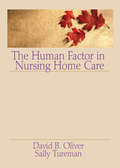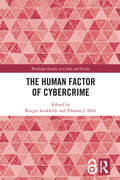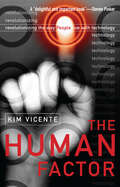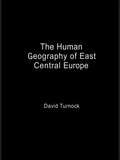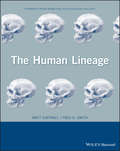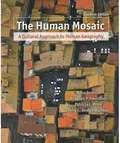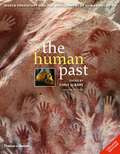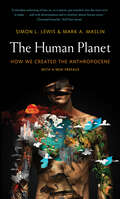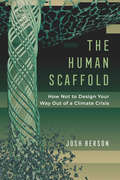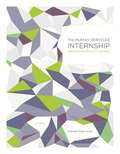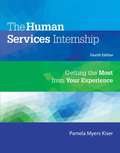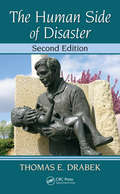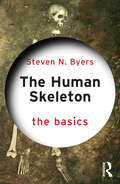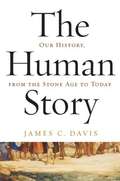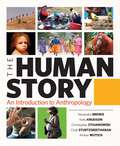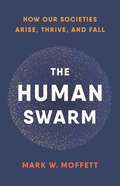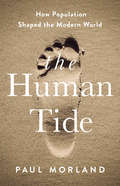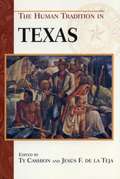- Table View
- List View
The Human Factor in Nursing Home Care
by David Oliver Sally TuremanIn an attempt to challenge the prevailing attitudes and images of nursing homes in America, the authors have written a touching book about the people and the relationships that are a part of nursing home care. Their extensive study of and experience with nursing home residents and caregivers reveal that our negative and often painful thoughts about nursing homes are not always well-founded. The authors effectively use monologue and dialogue to take the reader into the world of the nursing home to observe the work of the nursing home staffs, from administrators to housekeepers, as they become surrogate families and friends of the patients. Most moving are the thoughts and words of the residents themselves, especially as they describe their initial horror and anger at being in the nursing home, and their feelings of abandonment and loss of self-esteem. Valuable for both undergraduate and graduate courses in nursing, social work, psychology, death and dying, pastoral care and counseling, this comprehensive volume is useful as a primary or supplementary text.BACKCOVER COPY In an attempt to challenge the prevailing attitudes and images of nursing homes in America, David Oliver and Sally Tureman have written a touching book about the people and the relationships that are a part of nursing home care. Their extensive study of and experience with nursing home residents and caregivers reveal that our negative and often painful thoughts about nursing homes are not always well-founded. The authors effectively use monologue and dialogue to take the reader into the world of the nursing home to observe the work of the nursing home staffs, from administrators to housekeepers, as they become surrogate families and friends of the patients. Most moving are the thoughts and words of the residents themselves, especially as they describe their initial horror and anger at being in the nursing home, and their feelings of abandonment and loss of self-esteem. The Human Factor in Nursing Home Care provides a new and refreshing perspective of those who provide care in nursing homes and those who receive it. And, in the end, it challenges the reader to consider his or her own images of aging and of dying.
The Human Factor of Cybercrime (Routledge Studies in Crime and Society)
by Thomas J. Holt Rutger LeukfeldtCybercrimes are often viewed as technical offenses that require technical solutions, such as antivirus programs or automated intrusion detection tools. However, these crimes are committed by individuals or networks of people which prey upon human victims and are detected and prosecuted by criminal justice personnel. As a result, human decision-making plays a substantial role in the course of an offence, the justice response, and policymakers' attempts to legislate against these crimes. This book focuses on the human factor in cybercrime: its offenders, victims, and parties involved in tackling cybercrime. The distinct nature of cybercrime has consequences for the entire spectrum of crime and raises myriad questions about the nature of offending and victimization. For example, are cybercriminals the same as traditional offenders, or are there new offender types with distinct characteristics and motives? What foreground and situational characteristics influence the decision-making process of offenders? Which personal and situational characteristics provide an increased or decreased risk of cybercrime victimization? This book brings together leading criminologists from around the world to consider these questions and examine all facets of victimization, offending, offender networks, and policy responses.
The Human Factor: Revolutionizing the Way People Live with Technology
by Kim J. VicenteIn this incessantly readable, groundbreaking work, Vincente makes vividly clear how we can bridge the widening gap between people and technology. He investigates every level of human activity - from simple matters such as our hand-eye coordination to complex human systems such as government regulatory agencies, and why businesses would benefit from making consumer goods easier to use. He shows us why we all have a vital stake in reforming the aviation industry, the health industry, and the way we live day-to-day with technology.
The Human Geography of East Central Europe (Routledge Studies in Human Geography)
by David TurnockThe Human Geography of East Central Europe examines the geography of the transition economies that were not formerly part of the Soviet Union: Albania, Bosnia & Hercegovina, Bulgaria, Croatia, The Czech Republic, Hungary, Macedonia, Poland, Romania, Slovakia, Slovenia, Yugoslavia and East Germany. There is a thematic treatment beginning with the landscape and historical background, which moves on to the social and economic geography (industry, agriculture and infrastructure) and to issues concerning regional development and environmental protection.
The Human Lineage
by Kaye B. Brown Fred H. Smith Matt Cartmill"This textbook, aimed at advanced undergraduates and postgraduates in paleoanthropology courses, tackles a rather difficult task--that of presenting the substantial body of paleontological, genetic, geological and archaeological evidence regarding human evolution, and the associated scientific history, in a logical and readable way without sacrificing either clarity or detail... the sheer quality of the writing and explanatory synthesis in this book will undoubtedly make it a valuable resource for students for many years."--PaleoAnthropology, 2010This book focuses on the last ten million years of human history, from the hominoid radiations to the emergence and diversification of modern humanity. It draws upon the fossil record to shed light on the key scientific issues, principles, methods, and history in paleoanthropology. The book proceeds through the fossil record of human evolution by historical stages representing the acquisition of major human features that explain the success and distinctive properties of modern Homo sapiens.Key features:Provides thorough coverage of the fossil record and sites, with data on key variables such as cranial capacity and body size estimatesOffers a balanced, critical assessment of the interpretative models explaining pattern in the fossil recordEach chapter incorporates a "Blind Alley" box focusing on once prevalent ideas now rejected such as the arboreal theory, seed-eating, single-species hypothesis, and Piltdown manPromotes critical thinking by students while allowing instructors flexibility in structuring their teachingDensely illustrated with informative, well-labelled anatomical drawings and photographsIncludes an annotated bibliography for advanced inquiryWritten by established leaders in the field, providing depth of expertise on evolutionary theory and anatomy through to functional morphology, this textbook is essential reading for all advanced undergraduate students and beginning graduate students in biological anthropology.
The Human Mosaic
by Mona Domosh Roderick P. Neumann Patricia L. Price Terry G. Jordan-BychkovCarrying forward the legacy of original author Terry Jordan-Bychkov, coauthors Mona Domosh, Roderick Neumann and Patricia Price have again provided a thoroughly up-to-date new edition of the classic text,The Human Mosaic. The new edition offers a compelling guided tour of contemporary geography that updates the original's unique Five Theme approach while captivating students with the ways today's geographers interpret our ever more globalized, interdependent world.
The Human Motor: Or the Scientific Foundations of Labour and Industry (Routledge Library Editions: Labour Economics #2)
by Jules AmarFirst published in 1920. This study examines the science of industrial work and the advances in its application to the economic life of the community. The author commences this volume with a brief explanation of the general principles of Theoretical Mechanics which have been applied in the study of the Human Motor. Space has also been devoted to the explanation of the laws of thermo-dynamics and of the Conservation of Energy. These provide the reader with the means by which muscular work and fatigue can be measured. This title will be of interest to students of economics and business.
The Human Network: How Your Social Position Determines Your Power, Beliefs, and Behaviors
by Matthew O. JacksonHere is a fresh, intriguing, and, above all, authoritative book about how our sometimes hidden positions in various social structures—our human networks—shape how we think and behave, and inform our very outlook on life.Inequality, social immobility, and political polarization are only a few crucial phenomena driven by the inevitability of social structures. Social structures determine who has power and influence, account for why people fail to assimilate basic facts, and enlarge our understanding of patterns of contagion—from the spread of disease to financial crises. Despite their primary role in shaping our lives, human networks are often overlooked when we try to account for our most important political and economic practices. Matthew O. Jackson brilliantly illuminates the complexity of the social networks in which we are—often unwittingly—positioned and aims to facilitate a deeper appreciation of why we are who we are.Ranging across disciplines—psychology, behavioral economics, sociology, and business—and rich with historical analogies and anecdotes, The Human Network provides a galvanizing account of what can drive success or failure in life.
The Human Past (Fifth Edition): World Prehistory And The Development Of Human Societies
by Chris ScarreA more diverse author team brings a fresh perspective to a comprehensive text With the most diverse author team to date, the Fifth Edition brings new specialists, new research, and new perspectives to the field, connecting our present to the past in a more equitable and representative way. Careful reconsideration of each chapter’s level of detail resulted in a book that is 13% briefer, but which remains a comprehensive authority on world prehistory, with each chapter written by leading experts on that region.
The Human Past: World Prehistory and the Development of Human Societies
by Chris ScarreTextbook on humans, from 6 million years ago to early civilizations.
The Human Planet: How We Created the Anthropocene
by Mark A. Maslin Simon L. LewisAn exploration of the Anthropocene and “a relentless reckoning of how we, as a species, got ourselves into the mess we’re in today” (The Wall Street Journal).Meteorites, mega-volcanoes, and plate tectonics—the old forces of nature—have transformed Earth for millions of years. They are now joined by a new geological force—humans. Our actions have driven Earth into a new geological epoch, the Anthropocene. For the first time in our home planet's 4.5-billion-year history a single species is increasingly dictating Earth’s future.To some the Anthropocene symbolizes a future of superlative control of our environment. To others it is the height of hubris, the illusion of our mastery over nature. Whatever your view, just below the surface of this odd-sounding scientific word—the Anthropocene—is a heady mix of science, philosophy, history, and politics linked to our deepest fears and utopian visions.Tracing our environmental impacts through time, scientists Simon Lewis and Mark Maslin reveal a new view of human history and a new outlook for the future of humanity in the unstable world we have created.
The Human Rights City: New York, San Francisco, Barcelona (Routledge Advances in Sociology)
by Michele GrigoloWe are used to thinking of human rights as a matter for state governments to deal with. Much less investigated is the question of what cities do with them, even though urban communities and municipalities have been discussing human rights for quite some time. In this volume, Grigolo borrows the concept of ‘the human rights city’ to invite us to think about a new urban utopia: a place where human rights strive to guide urban life. By turning the question of the meaning and use of human rights in cities into the object of critical investigation, this book tracks the genesis, institutionalisation and implementation of human rights in cities, focussing on New York, San Francisco and Barcelona. Touching also upon matters such as women’s rights, LGBT rights and migrant rights, The Human Rights City emphasises how human rights can serve urban justice but also a neoliberal practice of the city. This book is a useful resource for scholars and students interested in fields such as Sociology of Human Rights, Sociology of Law, International Law, Urban Sociology, Political Sociology and Social Policies.
The Human Scaffold: How Not to Design Your Way Out of a Climate Crisis (Great Transformations #2)
by Josh BersonHumanity has precipitated a planetary crisis of resource consumption—a crisis of stuff. So ingrained is our stuff-centric view that we can barely imagine a way out beyond substituting a new portmanteau of material things for the one we have today.In The Human Scaffold, anthropologist Josh Berson offers a new theory of adaptation to environmental change. Drawing on niche construction, evolutionary game theory, and the enactive view of cognition, Berson considers cases in the archaeology of adaptation in which technology in the conventional sense was virtually absent. Far from representing anomalies, these cases exemplify an enduring feature of human behavior that has implications for our own fate.The time has come to ask what the environmental crisis demands of us not as consumers but as biological beings. The Human Scaffold offers a starting point.
The Human Services Internship Experience: Helping Students Find Their Way
by Marianne R. Woodside"This text is the ‘bread and butter’ for interns who seek to work in human service fields." -Fred Hall, Mississippi College The Human Services Internship Experience: Helping Students Find Their Way aims to help students in field-based courses bridge theory and practice during their internships. The goal is to show students how to apply their academic work in a real-world setting and to confirm and expand their identity as human service professionals. To meet this goal, Marianne Woodside assists students in developing that identity, learn to work within an agency setting, learn to use supervision effectively, and to be aware of multicultural and ethical perspectives in human service delivery and supervision as well as develop the appropriate knowledge, skills, and values to effectively perform the multiple roles of the human service professional. Students will learn how to successfully conclude the internship and transition from intern to employee.
The Human Services Internship Experience: Helping Students Find Their Way
by Marianne R. Woodside"This text is the ‘bread and butter’ for interns who seek to work in human service fields." -Fred Hall, Mississippi College The Human Services Internship Experience: Helping Students Find Their Way aims to help students in field-based courses bridge theory and practice during their internships. The goal is to show students how to apply their academic work in a real-world setting and to confirm and expand their identity as human service professionals. To meet this goal, Marianne Woodside assists students in developing that identity, learn to work within an agency setting, learn to use supervision effectively, and to be aware of multicultural and ethical perspectives in human service delivery and supervision as well as develop the appropriate knowledge, skills, and values to effectively perform the multiple roles of the human service professional. Students will learn how to successfully conclude the internship and transition from intern to employee.
The Human Services Internship: Getting the Most from Your Experience (Third Edition)
by Pamela Myers KiserCovering information from the beginning to the end of an internship, this practical, hands-on book engages readers in a process of thinking and reflection--helping them analyze different experiences and situations they encounter day to day in their field work. A unique six-step model guides readers in enhancing self-awareness, integrating the knowledge and values of the profession, recognizing challenging and dissonant situations, decision-making, and follow-through.
The Human Services Internship: Getting the most from your Experience
by Pamela Myers KiserChapters focused on ethics, diversity, communication skills, stress management, and other key topics help you integrate your classroom knowledge with your experiences in the field. Supporting you through every stage of the internship process, the book explains what to expect at various points in the internship's development, offers tips for avoiding potential pitfalls, and includes examples of other students' experiences.
The Human Side of Disaster
by Thomas E. DrabekSince the first edition of The Human Side of Disaster was published in 2009, new catastrophes have plagued the globe, including earthquakes in Haiti and New Zealand, tornadoes in Alabama and Missouri, floods in numerous locations, Hurricane Sandy, and the infamous BP oil spill. Enhanced with new cases and real-world examples, The Human Side of Disaster, Second Edition presents an updated summary of the social science knowledge base of human responses to disaster. Dr. Drabek draws upon his 40-plus years of conducting research on individual, group, and organizational responses to disaster to illustrate and integrate key insights from the social sciences to teach us how to anticipate human behaviors in crisis. The book begins with a series of original short stories rooted within actual disaster events. These stories are woven into the entire text to demonstrate essential findings from the research literature. Dr. Drabek provides an overview of the range of disasters and hazards confronting the public and an explanation of why these are increasing each year, both in number and scope of impact. The core of the book is a summary of key findings regarding disaster warning responses, evacuation behavior, initial post-impact survival behavior, traditional and emergent roles of volunteers, and both short-term and longer-term disaster impacts. The theme of "organized-disorganization" is used to illustrate multiorganizational response networks that form the key managerial task for local emergency managers. The final chapter provides a new vision for the emergency management profession—one that reflects a more strategic approach wherein disasters are viewed as non-routine social problems. This book will continue to be an invaluable reference for professionals and students in emergency management and public policy and aid organizations who need to understand human behavior and how best to communicate and work with the public in disaster situations.
The Human Skeleton: The Basics (The Basics)
by Steven N. ByersThe Human Skeleton: The Basics provides an accessible overview of the basic characteristics of the human skeleton that can be used to understand the life and (sometimes) death of persons represented only by their skeletons. Topics covered include: Osteology (bones) and Odontology (teeth), Estimating Ancestry, Sex, and Age at Death, Calculating Stature, Skeletal Anomalies, Cultural Modifications, Cranial and Dental Pathological Conditions, Disease and Trauma. The Human Skeleton: The Basics is an essential read for students, faculty, and professionals in anthropology, biology, forensics, and criminal justice.
The Human Story
by James C. DavisHas there ever been a history of the world as readable as this? In The Human Story, James C. Davis takes us on a journey to ancient times, telling how peoples of the world settled down and founded cities, conquered neighbors, and established religions, and continues over the course of history, when they fought two nearly global wars and journeyed into space. Davis's account is swift and clear, never dull or dry. He lightens it with pungent anecdotes and witty quotes. Although this compact volume may not be hard to pick up, it's definitely hard to put down. For example, on the death of Alexander the Great, who in a decade had never lost a single battle, and who had staked out an empire that spanned the entire Near East and Egypt, Davis writes: "When they heard how ill he was, the king's devoted troops insisted on seeing him. He couldn't speak, but as his soldiers -- every one -- filed by in silence, Alexander's eyes uttered his farewells. He died in June 323 B.C., at the ripe old age of thirty-two." In similar fashion Davis recounts Russia's triumph in the space race as it happened on an autumn night in 1957: "A bugle sounded, flames erupted, and with a roar like rolling thunder, Russia's rocket lifted off. It bore aloft the earth's first artificial satellite, a shiny sphere the size of a basketball. Its name was Sputnik, meaning 'companion' or 'fellow traveler' (through space). The watchers shouted, 'Off. She's off. Our baby's off!' Some danced; others kissed and waved their arms." Though we live in an age of many doubts, James C. Davis thinks we humans are advancing. As The Human Story ends, he concludes, "The world's still cruel; that's understood, / But once was worse. So far so good."
The Human Story (First Edition): An Introduction To Anthropology
by Alexandra Brewis Amber Wutich Cindi SturtzSreetharan Kelly Knudson Christopher StojanowskiThe only true four-fields introduction to anthropology The Human Story is the first general anthropology textbook written by award-winning scholars and teachers from all four of the discipline’s subfields. In each chapter, the authors weave perspectives from cultural anthropology, biological anthropology, archaeology, and linguistic anthropology into an engaging narrative, inviting students to think anthropologically about themselves and the world around them.?By emphasizing contemporary research from a diverse cast of anthropologists, the authors provide students with a uniquely holistic, balanced, and up-to-date view of the discipline. To provide students with the most effective possible learning experience, a dynamic media package features a Norton Illumine Ebook with animations and Anthropology in 3D models. This purchase offers access to the digital ebook only.
The Human Swarm: How Our Societies Arise, Thrive, and Fall
by Mark W. MoffettThe epic story and ultimate big history of how human society evolved from intimate chimp communities into the sprawling civilizations of a world-dominating species <P><P>If a chimpanzee ventures into the territory of a different group, it will almost certainly be killed. But a New Yorker can fly to Los Angeles--or Borneo--with very little fear. <P><P>Psychologists have done little to explain this: for years, they have held that our biology puts a hard upper limit--about 150 people--on the size of our social groups. But human societies are in fact vastly larger. How do we manage--by and large--to get along with each other? <P><P>In this paradigm-shattering book, biologist Mark W. Moffett draws on findings in psychology, sociology and anthropology to explain the social adaptations that bind societies. He explores how the tension between identity and anonymity defines how societies develop, function, and fail. <P><P>Surpassing Guns, Germs, and Steel and Sapiens, The Human Swarm reveals how mankind created sprawling civilizations of unrivaled complexity--and what it will take to sustain them.
The Human Tide: How Population Shaped the Modern World
by Paul MorlandA dazzling new history of the irrepressible demographic changes and mass migrations that have made and unmade nations, continents, and empiresThe rise and fall of the British Empire; the emergence of America as a superpower; the ebb and flow of global challenges from Nazi Germany, Imperial Japan, and Soviet Russia. These are the headlines of history, but they cannot be properly grasped without understanding the role that population has played.The Human Tide shows how periods of rapid population transition--a phenomenon that first emerged in the British Isles but gradually spread across the globe--shaped the course of world history. Demography--the study of population--is the key to unlocking an understanding of the world we live in and how we got here. Demographic changes explain why the Arab Spring came and went, how China rose so meteorically, and why Britain voted for Brexit and America for Donald Trump. Sweeping from Europe to the Americas, China, East Asia, the Middle East, and North Africa, The Human Tide is a panoramic view of the sheer power of numbers.
The Human Toll: Taxation and Slavery in Colonial America
by Anthony C. InfantiHow the thirteen colonies deployed the power of taxation to support, promote, and perpetuate the institution of slaveryThe Human Toll documents how the American colonies used tax law to dehumanize enslaved persons, taxing them alongside valuable commodities upon their forced arrival and then as wealth-generating assets in the hands of slaveholders. Anthony C. Infanti examines how taxation also proved to be an important component for subjugating and controlling enslaved persons, both through its shaping of the composition of new arrivals to the colonies and through its funding of financial compensation to slaveholders for the destruction of their “property” to ensure their cooperation in the administration of capital punishment. The variety of tax mechanisms chosen to fund slaveholder compensation payments conveyed messages about who was thought to benefit from—and, therefore, who should shoulder the burden of—slaveholder compensation while opening a revealing window into these colonial societies.While the story of colonial tax law is intrinsically linked to advancing slavery and racism, Infanti reveals how several colonies used the power of taxation as a means of curtailing the slave trade. Though often self-interested, these efforts show how taxation can be used not only in the service of evil but also to correct societal injustices. Providing a fascinating account of slavery’s economic entrenchment through the history of American tax law, The Human Toll urges us to consider the lessons that fiscal history holds for those working in the reparations movement today.
The Human Tradition In Texas
by Jesus F. de la Teja Ty CashionThrough the lives of a variety of Texans who put a human face on the state's history, this work presents the history of the 'Lone Star State'.
